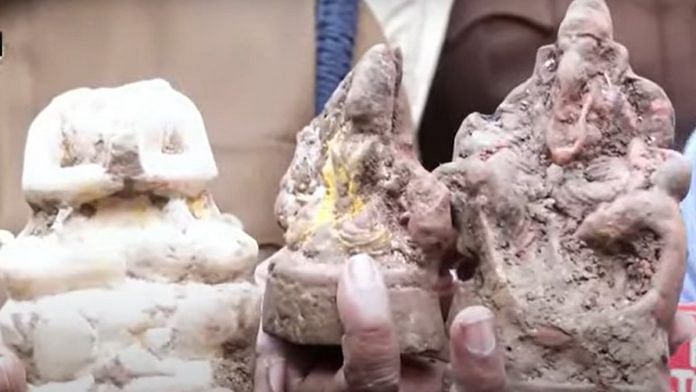Within days of the Supreme Court’s stay on fresh suits to survey mosques for temple structures beneath them, new temples are springing up before our eyes. That too in largely Muslim-inhabited areas.
If you’ve watched Hindi television news channels for any length of time in the last few days, you would have seen a temple revealed behind closed doors in Sambhal — approximately 1.5 kilometres from the Shahi Jama Masjid, where a survey last month led to communal clashes that left at least four people dead.
The Hindi news channels hailed the mandir ‘discovery’ almost as a Eureka moment: “46-year-old temple unearthed,” reported India News. “One more temple found in Sambhal,” declared ABP News.
The next day, news arrived of a Shiva temple in Varanasi’s Madanpura that had been standing there in plain sight for 250 years, with just a simple lock on it. According to The Times of India, local Muslim residents had “no objection to the reopening of the temple or continuation of prayers in it.”
That was not all. No sooner had the police broken down the doors hiding the Hanuman temple in Sambhal, they unearthed a nearby well containing religious “moortis”. Promptly, Hindi news channels dropped the debate on the Constitution in the Rajya Sabha—as well Congress MP Priyanka Gandhi’s `Palestine’ tote bag, which had raised BJP eyebrows in Parliament—and raced across to Sambhal.
Since Monday, there has been day-long coverage of the discovered idols and the crowds that had immediately flocked there to pray (Times Now Navbharat). On Wednesday, we were still being shown people thronging to the temple and the digging up of the “chabootra” (Aaj Tak).
“How many temples have been burnt down, buried, or hidden in Sambhal?” asked India TV.
Also Read: Sambhal: A history of violence
Media frenzy, focus on the ‘other’
Since the communal disturbances in November, Sambhal and its temple trouble have remained in the news, especially on Hindi news channels, which have a large audience in Uttar Pradesh. Still, the non-stop coverage of the Hanuman temple and the three idols is exceptional.
“Idol after idol is being discovered,” reported a surprised ABP News. Other Hindi news channels displayed the same sense of awe as they focused on the idols coming out of the well.
We were treated to visuals of police cleaning idols (Aaj Tak), labourers digging the well, and devotees singing bhajans (Zee News). We met Hindu families who recounted their experiences before they fled the area during communal violence in 1978 (India News, India TV). Meanwhile, reporters roamed outside the heavily guarded temple, describing the discoveries and talking to the police and devotees (TNNB).
Hindi newspapers also covered the discovery of the temples in depth. This Dainik Bhaskar story gives a very clear picture of the idols, the well, how the temple was revealed, plank by plank—and how it had been appropriated by the “other community”. In a similar vein, an Amar Ujala article described how the temple was “freed from encroachment” by people of the “other community”.
However, for once, the communal angle was treated with a light hand. One reporter on India TV pointed out that while the temple had been boarded up, it had been preserved by the local Muslim population.
This was reiterated in much of the Hindi print media too: Jagran quoted the local qazi, who said that the temple being left intact indicated how Muslims respect other religions.
On Wednesday, The Times of India reported that Muslim residents had “started demolishing their own homes, which they had built after ‘encroaching on the temple property’.”
Also Read: Isn’t it true Sambhal violence was result of tensions between ‘desi & foreign Muslims,’ asks Yogi
Electric raids & charged rhetoric
In between, Uttar Pradesh Chief Minister Yogi Adityanath — who frequently mentions Sambhal in his public utterances — made headlines with his Vidhan Sabha statement that “209 Hindus lost their lives in Sambhal since 1947”.
As if this wasn’t enough about Sambhal, the Hindi news media was filled with stories about “bijli chori” by Muslim residents there. India TV claimed that “1,250 FIRs” had been filed in this respect. We saw a new electricity meter being installed at the house of local Samajwadi MP Zia Ur Rahman Barq. The reporter, sarcastically, pointed out that there was a massive police contingent present simply to ensure the installation of the meter.
One did wonder whether similar action had been taken in other parts of Sambhal too, or was it just this locality? And why it received so much attention. Just to target Barq?
We know only too well that Hindi news channels report Hindu-Muslim stories daily. Most of them feature debates between Hindu and Muslim religious leaders, both sides as strident and disagreeable to each other as possible. This is routine. What it does to communal relations in the Hindi-speaking audience cannot be underestimated: it has “Danger” written all over it.
However, Sudarshan News takes it to another level. Known for its extreme views on Muslims, it never loses an opportunity to sensationalise its coverage. It even has a news segment called “Jihad News”, which carries stories about “jihadi parivar” in different cities. On Monday, it ‘reported’ that a Hindu teenager died by suicide after harassment by a ‘jihadi’.
This demonisation of Muslims should be unacceptable.
The author tweets @shailajabajpai. Views are personal.
(Edited by Asavari Singh)







It may be matter of theater and stories for western media. You can consider it as old heritage and history surfaced on top. It may not be a matter of concern for the writer if her idols were buried and temples were destroyed. The stones and remains are the witness of atrocities.
Mosqueless India on the cards